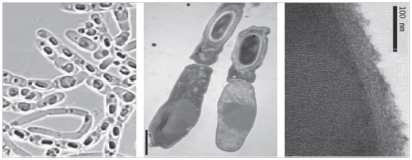分享到
Division of labour and terminal differentiation in a novel Bacillus thuringiensis strain
Recently, researchers at State Key Laboratory for Biology of Plant Diseases and Insect Pests, Institute of Plant Protection, Chinese Academy of Agricultural Sciences (CAAS) have a new finding on Bacillus thuringiensis which is well known to produce insecticidal crystal in the sporulating cells. A novel B. thuringiensis isolate LM1212 was found to produce crystal in non-sporulation cell. The research results have been published online in the International Society of Microbiology Ecology (ISME) Journal on August 1st, 2014.
B. thuringiensis (Bt) is a spore-forming bacterium, which is genetically closely related to B. anthracis, the agent of anthrax, and to B. cereus, an opportunistic human pathogen. The defining feature that distinguishes Bt from its relatives is its ability to produce crystal inclusions in the sporulating cells. These toxins are solubilized after ingestion and are cooperative public goods in insect hosts.


B. thuringiensis (Bt) is a spore-forming bacterium, which is genetically closely related to B. anthracis, the agent of anthrax, and to B. cereus, an opportunistic human pathogen. The defining feature that distinguishes Bt from its relatives is its ability to produce crystal inclusions in the sporulating cells. These toxins are solubilized after ingestion and are cooperative public goods in insect hosts.


In this study, we describe a Bt strain LM1212 that presents the unique ability to terminally differentiate into crystal producers and spore formers. Transcriptional analysis based on lacZ and gfp reporter genes suggested that this phenotype is the consequence of a new type of cell differentiation associated with a novel regulation mode of cry gene expression. The differentiating crystal-producer phenotype has higher spore productivity than a typical Bt strain and is better able to compete with Cry toxin null ‘cheaters’. Potentially, this division of labour provides additional fitness benefits in terms of spore viability or durability of Cry toxin.
More details are available on the bellow links:
http://www.nature.com/ismej/journal/vaop/ncurrent/full/ismej2014122a.html
More details are available on the bellow links:
http://www.nature.com/ismej/journal/vaop/ncurrent/full/ismej2014122a.html
By Fuping Song
fpsong@ippcaas.cn
fpsong@ippcaas.cn
Latest News
-
 Apr 18, 2024Opening Ceremony of the Training Workshop on Wheat Head Scab Resistance Breeding and Pest Control in Africa Held in CAAS
Apr 18, 2024Opening Ceremony of the Training Workshop on Wheat Head Scab Resistance Breeding and Pest Control in Africa Held in CAAS -
 Apr 03, 2024IPPCAAS Co-organized the Training Workshop on Management and Application of Biopesticides in Nepal
Apr 03, 2024IPPCAAS Co-organized the Training Workshop on Management and Application of Biopesticides in Nepal -
 Mar 28, 2024Delegation from the School of Agriculture and Food Science of University College Dublin, Ireland Visit to IAS, CAAS
Mar 28, 2024Delegation from the School of Agriculture and Food Science of University College Dublin, Ireland Visit to IAS, CAAS -
 Mar 25, 2024Director of World Food Prize Foundation visited GSCAAS
Mar 25, 2024Director of World Food Prize Foundation visited GSCAAS -
 Mar 20, 2024Institute of Crop Sciences (ICS) and Syngenta Group Global Seeds Advance Collaborative Research in the Seed Industry
Mar 20, 2024Institute of Crop Sciences (ICS) and Syngenta Group Global Seeds Advance Collaborative Research in the Seed Industry
